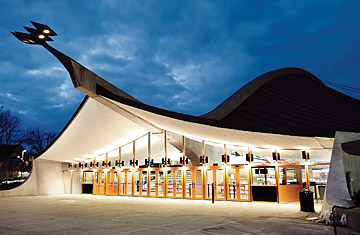
Yale's Ingalls Rink is Saarinen at his most voluptuous.
In the decades after World War II, when America was assuming its new role as the center of the known universe, Eero Saarinen was the man who supplied it with an architecture suited to the place where the future happened. For the marquee names of American capitalism — General Motors, IBM, CBS — he designed buildings that were more than just corporate facilities. They were signposts for modernity, theirs and the nation's. For New York City and Washington, Saarinen provided airport terminals that were symbols of the excitement and glamour of air travel. (It was once possible to think of air travel that way.) Then there was his St. Louis Gateway Arch, a gleaming vertical curve that even now could serve as the logo for Tomorrowland.
When he died in 1961 — at 51 years of age, after surgery for a brain tumor — Saarinen was just arriving at the peak of his fame and success. He'd been on the cover of TIME, he had A-list clients, and his streamlined furniture for Knoll was so of the moment that Coca-Cola used his Womb chair in a magazine ad showing an exhausted Santa Claus slumped in it.
But if his momentary fame was secure, his long-term reputation was unstable. To rigorous Modernists, there was something slack and accommodating about his work. The swelling lines of his TWA terminal at what is now JFK International Airport — weren't they a bit too delicious, too far from the square-shouldered Modernist grid? The bright blue exterior of his IBM facility in Rochester, Minn. — since when did austere Modernists do big color?
Over the past few years, however, there's been a Saarinen reappraisal. Set free by computer-aided design, contemporary architects like Santiago Calatrava, Frank Gehry and Zaha Hadid have moved quite a distance from Modernist orthodoxy. And a great deal of Saarinen's work, especially his adventures in fluid geometry, today looks as if it's the predecessor of theirs. It's easier now to regard his expressive buildings as a principled attempt to reconcile the Modernist drive to purify and clarify with the abiding human desire for something that strikes other, warmer and no less essential chords.
Yale, where Saarinen earned his degree in the 1930s, has been restoring the buildings he designed in the 1950s for its campus. Work on the David S. Ingalls Hockey Rink, designed in 1956, has just been completed. An obvious precursor to the arabesques of the TWA terminal, Ingalls represents Saarinen at his most voluptuous, with a roofline forming a gentle curve that swells in the middle, then dips and rises at both ends like the prow of a ship, or two prows. Yalies call it the Whale. Meanwhile, at Yale's Morse College, an undergraduate residential complex by Saarinen that was inspired by the plan and proportions of an Italian hill town, something close to a gut renovation is nearly finished. Restoration of the adjoining Stiles College begins in the spring.
The rereading of Saarinen gathered speed in 2002, when a trove of his papers and drawings was donated to the Yale University Library by the architect Kevin Roche, who had joined Saarinen's firm as a young man and saw to completion several important Saarinen projects that were unfinished at the time of his death. That archive laid the basis for a museum show that began traveling in 2006 and runs through Jan. 31 at the Museum of the City of New York before moving to Yale, its final stop, on Feb. 19. It tells you something about Saarinen's tricky place in the architectural canon that nearly half a century after his death, this is the first full career retrospective devoted entirely to his work.
